You can easily learn how to knit double-sided patterns. To do this, you need to find out what products they are intended for and study the conventional symbols for loops in the diagrams. You should also consider several detailed descriptions of popular patterns and try to repeat them.
What is double-sided knitting, what products is it intended for?
To knit a thing with the same pattern on both sides, craftsmen use the technique of double-sided knitting. This method allows you to make the fabric beautiful from the front and back sides. A thing knitted according to this principle can be put on and unfolded in any way, while the relief pattern will remain visible.
For what products is this knitting method relevant:
- scarves and snoods;
- blankets and bedspreads;
- stoles and shawls.
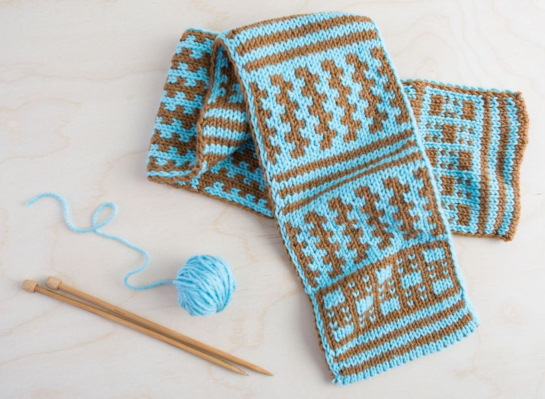
Depending on the type of pattern, in some cases the design does differ, but not dramatically. For example, if you knit with a 1x2 or 2x3 elastic band, the stripes on the front and back sides will be slightly different, but they will look good. Therefore, how to unfold and wear such a product - it makes no difference.
Conventional symbols and abbreviations in diagrams
Double-sided patterns are knitted using special graphic patterns. The drawing is divided into cells, each of which is designated by a symbol. To decipher the schemes, you need to know the basic symbols. In the table below, you can find the meanings of the most common signs used in graphic descriptions for double-sided patterns.
| + | Edge loop |
| ■ | Face loop |
| ◫ | Purl stitch |
| ○ | Throwing |
| • | Knit 1 stitch together with yarn over |
| ♦ | Crossed front |
| ◢ | 2 knit together |
There are other symbols, but they are used rarely and only in very complex designs.
Patterns and descriptions of popular patterns for knitting scarves, blankets
Double-sided patterns are varied and can be simple or complex. Below are several descriptions of the most common options. To make the pattern more convex, experienced craftsmen recommend that beginners use medium-thickness threads without fluff. The needles should be 2 times thinner than the yarn. Then it will be more comfortable to work, the result will be more noticeable.
Before knitting a large item, you need to knit a small sample (10x10 cm fabric). This piece needs to be subjected to several tests: washed, dried and steamed.
Such a test will help to determine in advance how the yarn behaves in different conditions, whether the pattern holds its shape well and how much the thread shrinks. After these steps, it will be easier to calculate the required amount of yarn for the entire product.
Harnesses
This pattern is most often used for knitting scarves or snoods. The cords look the same on the inside and the outside.
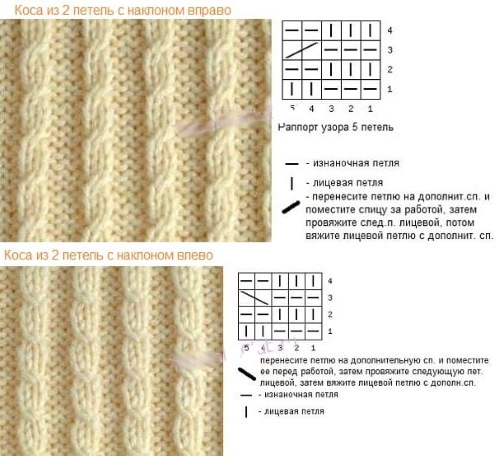
The pattern is based on a 2x2 elastic band with slanted loops. To knit a small sample, you need to dial a number of loops that will be divisible by 12, add 4 additional loops and 2 edge loops.
How to knit:
- All odd chains, starting from 1 to 5, should be knitted, alternating 2 front and 2 back loops. Removing edge loops at the beginning and end of the chain.
- Even stitches from 2 to 6, on the contrary, are knitted, alternating 2 purl and 2 knit stitches.
- In the 7th chain, remove the edge stitch, knit 2 front stitches and 2 back stitches. The next 8 stitches need to be crossed with a tilt to the right. To do this, transfer 4 stitches to an additional knitting needle and bring them back. Knit 2 front stitches and 2 back stitches. Knit the remaining stitches on the additional knitting needle in the same position as they are. 2 front stitches, 2 back stitches.
Then continue with steps 1 through 7.
Geometry
Double-sided patterns can be knitted with knitting needles in the form of geometric figures. These can be diamonds, squares, triangles and other options. In the description below, the pattern has the shape of an inverted diamond, as if the figure is lying on its side. This pattern is suitable for knitting a scarf or shawl. It is based on alternating front and back loops. At the beginning and end of each row, you need to remove 1 edge loop.
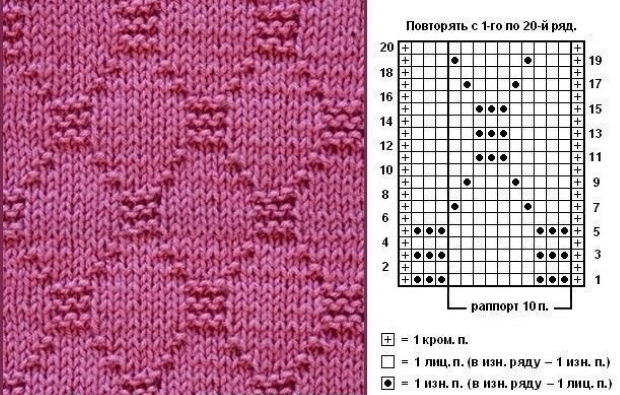
Step-by-step instructions (the item number matches the chain number):
- Knit 5 purl stitches, then 5 front stitches, removing the edge stitches.
- Knit 1 front loop, then 5 back loops and 4 front loops.
- Knit 3 purl, 5 knit, 1 purl and slip the edge loop again.
- Knit 2 front loops, then 5 back loops and finish the chain with 3 front loops.
- Knit 1 purl, 5 knit, 3 purl.
- Start the line with 4 knit stitches, then knit 5 purl stitches and 1 knit stitch.
- First knit 5 front loops, then 5 back loops.
- Make the chain mirror image of 7.
- Start with 4 purl stitches, knit 5 stitches and add 1 more purl stitch.
- This chain starts with 1 knit stitch, then knit 5 purl stitches and 3 knit stitches.
- In row 11, you need to knit 2 front loops and 5 back loops. Finish the chain with 2 front loops.
- Knit 3 stitches, then 5 stitches and finish the chain with 1 stitch.
- The last chain consists of 1 purl stitch, 5 knit stitches and 4 purl stitches at the end.
Repeat steps 1 through 14 until the end of knitting.
Rubber bands
The elastic bands are always double-sided, with the difference being that the stripes are positioned differently on each side.
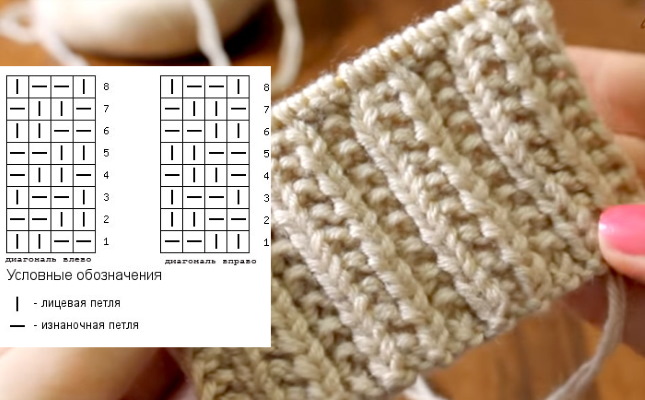
But among them there is a pattern that allows you to knit a warm and elastic fabric. It will look the same from all sides. It can be used not only for scarves, but also for decorating sleeves and collars on sweaters, as well as the main pattern for other products. This pattern is called double-sided curly elastic.
The pattern consists of only 2 rows:
- 1: Slip edge stitch and alternate 1 knit stitch and 1 purl stitch to end of line.
- 2: slip the edge stitch again, then knit 2 knit stitches, 3 purl stitches and 3 knit stitches. Alternate these stitches in the same order until the end of the chain.
Then chains 1 and 2 are repeated until the end of knitting.
Rice knitting
Double-sided rice is a dense knit. This pattern option is suitable for bedspreads, warm sweaters, hats and voluminous snoods with hoods. It looks especially good on thick wool yarn with an admixture of acrylic. To knit a small sample, you will need to dial an even number of loops and add 2 more for the edge loops. They need to be removed at the beginning and end of each row.

Detailed instructions:
- In the first chain, alternate 1 front and 1 back loop until the end.
- In the second chain you need to do the same. The front loops should be placed above the front loops, and the back loops above the back loops.
- The third chain begins with alternating 1 purl stitch and 1 knit stitch. Continue knitting until the next edge stitch.
- Similar to chain 2.
From points 1 to 4, all actions must be repeated.
Pearl pattern
One of the easiest patterns that can be knitted. The fabric is dense, so it is suitable for knitting snoods, sweaters and warm shawls.
The drawing consists of 2 chains:
- 1: Alternate 1 knit and 1 purl stitch to the end.
- 2: the front and back loops of this chain should be arranged in a checkerboard pattern, relative to row 1. If there is a "knot" at the bottom, then you need to knit the front loop, and if there is a "tick", then vice versa, the back loop.
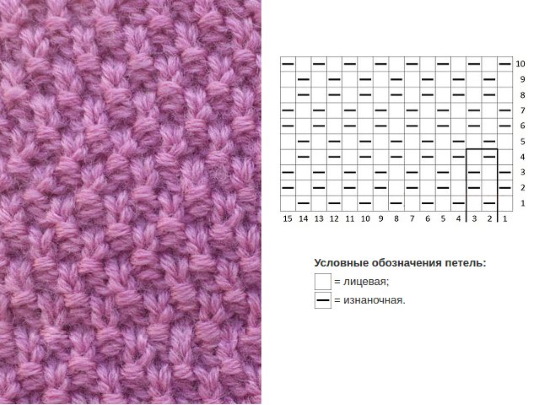
By alternating these 2 chains you will get a small pearl pattern that will be visible from both sides.
Checkerboard
The checkerboard pattern consists of alternating front and back stitches. The size of the squares can be large or small. It is most often used for knitting blankets, bedspreads, shawls and capes. Below is a description of a small checkerboard with small holes dividing the squares. This pattern is suitable for spring-summer items.
Pattern rapport: 8 loops in width, 12 chains in length. To knit a sample, you need to cast on a number of loops that is divisible by 8, and also add 2 additional and 2 edge loops.
How to knit:
- Start with 1 knit stitch, then knit 6 purl stitches and 1 knit stitch.
- The second chain must be knitted so that the front loops are above the front loops, and the back loops are above the back loops.
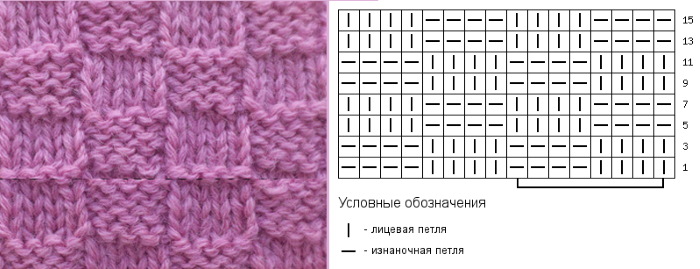
- 1 and 2 chains alternate until the total number of lines becomes 6.
- 7 chain starts with 1 purl, then 1 loop is removed without knitting. 3 purl, 1 not knitted and again 1 purl.
- Chain 8 is knitted similarly to chain 2, and chain 9 is knitted similarly to chain 7.
- In the 11th row, knit 1 front loop, remove 1, knit 2. Next, yarn over and knit 2 loops together with the front loop, tilting to the right. Knit the next 2 loops with the front loop tilted in the other direction. Yarn over again and knit 2 front loops. Remove 1 and knit 1 more front loop.
Repeat steps 1 through 6 until the end of the work.
Winding patterns
Double-sided patterns can be knitted with knitting needles in wavy and sinuous patterns. One of these patterns is called "snake". This pattern is embossed, so you should use smooth and thick threads to make the ornament even more noticeable. "Snake" can be used to knit snoods in 2 turns and regular scarves.
The pattern rapport consists of 8x8 loops. The description only includes face chains. Because all are purl, in this pattern you need to arrange all the loops in a mirror or checkerboard pattern.
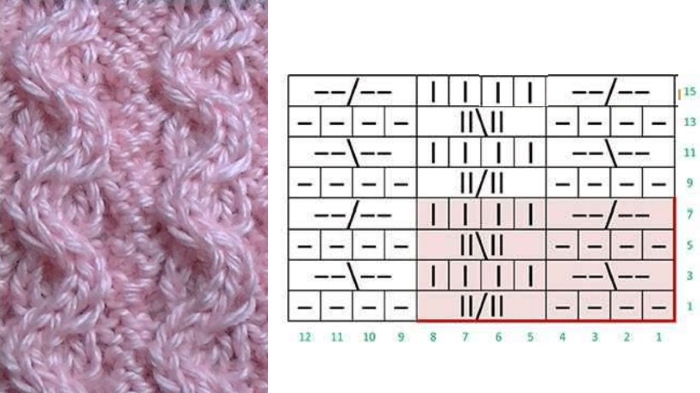
Step by step instructions:
- In the first chain, 4 loops must be crossed to the right side at once. To do this, 2 loops must be transferred to an additional knitting needle and left behind the entire work. Knit 2 loops as front loops, also knit 2 from the additional knitting needle as front loops. Finish the chain with 4 purl loops.
- The 3rd line starts with 4 front loops. Then you need to cross 4 loops to the left side. Transfer 2 loops to an additional knitting needle and move forward. Knit the next 2 loops as purl, then knit another 2 loops from the additional knitting needle, also as purl.
- In line 5, you need to cross the first 4 loops to the left side. This is done in the same way as in point 2. The chain ends with 4 purl loops.
- In the 7th row, knit 4 front loops and cross 4 loops on the right side.
All points are repeated again.
Interlacing
The intertwined patterns resemble a checkerboard pattern. They are also based on alternating purl and face loops. The result is squares of the same size but different textures. The pattern looks exactly the same on the reverse side. To knit a sample, you need to cast on as many loops as their number is divisible by 8.
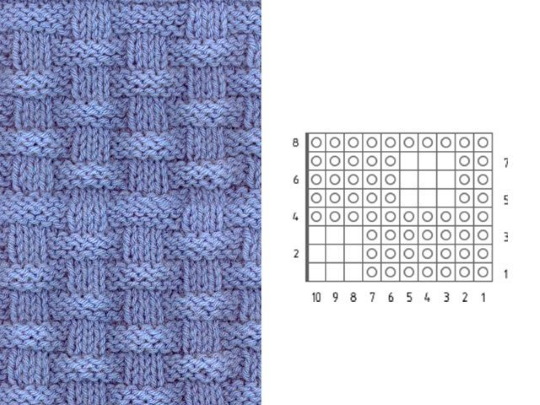
In this pattern, even and odd lines are knitted identically, so the description will be short:
- From 1st to 5th line: edge, 4 front, 4 back. Alternate these loops in the same sequence until the end of the chain.
- From the 6th to the 10th line: edge, 4 purl, 4 knit, alternate to the end.
Embossed diamonds
This is a complex but beautiful pattern. The relief is created by the strands intertwining to form diamonds. This pattern can be used to knit shawls, blankets and bedspreads. The pattern rapport is 10-11 stitches wide, 28 lines high.
To knit a sample, you need a number of loops multiple of 11 and 4 additional, as well as 2 edge loops. All even lines must be knitted according to the pattern, so in the description only odd ones. Each row begins and ends with an edge loop.
How to knit:
- From 1st to 5th row: cross the first 4 loops with a tilt to the left. Knit 7 purl loops, remove 1 without knitting. Cross the next 4 loops with a tilt to the right.
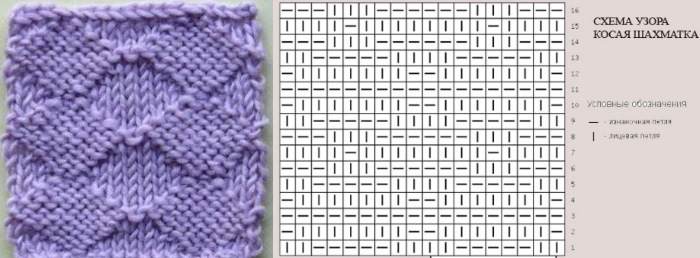
- In the 3rd chain, knit 4 front loops, 7 back loops and another 4 front loops.
- In the 7th chain, knit 2 front loops, make 1 yarn over. Then comes 1 front loop, knit 2 loops together with a tilt to the left side. Next, you need to make 5 purl, knit 2 together with a tilt to the right side. Now you need 1 purl, 1 yarn over and 1 front loop. Again knit 2 two together tilting to the left side.
- In the 9th chain, knit 2 knit stitches and 1 yarn over. Then 1 purl stitch, 1 yarn over and 1 knit stitch. Knit the next 2 stitches together, tilting to the left. 3 purl stitches, 2 together tilting to the right, 1 knit stitch. 1 yarn over, then 1 purl stitch and yarn over again. 1 knit stitch, 2 together, tilting to the left.
- Chain 11 starts with 2 knits, 1 yarn over, and 3 purl. Then comes 1 more yarn over, 1 knit, 2 together with a tilt to the left. Then again 1 purl and 2 together with a tilt to the right. Then 1 knit and a yarn over, and then 3 purl and a yarn over. Then 1 knit, 2 together with a tilt to the left.
- In the 13th row: 2 knits, 1 yarn over, 5 purl, 1 yarn over, 1 knit, 2 with a tilt to the left. 2 knits, 1 yarn over, 5 purl. Again 1 yarn over and 2 knits.
- Lines 15 and 19 are knitted the same way: 2 front, then 7 back. Cross 4 front with a tilt to the left. Then again knit 7 back and 2 front.
- In the 17th row: 2 front and 7 back, then 4 front. Then 7 back and 2 front loops.
- 21 chains start with 1 knit and 2 knitted together with a left tilt. 5 purl and 2 more together with a right tilt. Again 1 knit, yarn over, 1 knit and 2 with a left tilt. Then 5 purl, 2 with a right tilt and 1 knit.
- Line 23: 1 knit, 2 tilted to the left. 3 purl, 2 tilted to the right. Next 1 knit, 1 yarn over, 1 purl, yarn over again and 1 knit. 2 tilted to the left. Now 3 purl, 2 tilted to the right and 1 knit.
- In row 26: 1 front, 2 with a left tilt, 1 back and 2 with a right tilt. 1 front, yarn over, 3 back, yarn over. 1 front, 2 with a left tilt, 1 back. 2 loops with a right tilt, 1 front loop.
- 27th chain: 1 knit, 1 slanted to the left, 2 knits, 1 yarn over. 5 purl, yarn over, 1 knit, 2 slanted to the left and 2 knits.
From line 28, all points from 1 to 27 must be repeated.
Zigzag
Double-sided zigzag knitting patterns are suitable for knitting hats and snoods, as well as bedspreads. The pattern is based on alternating front and back loops.
The pattern rapport described below is 16x16. Even lines should be knitted based on the resulting pattern, so only odd lines are described.
Step by step instructions:
- In 1 row, knit 10 front loops, then alternate 2 back loops and 2 front loops.
- 3 chain starts with 8 purl, then 2 times alternate 2 knit and 2 purl.
- In the 5th chain, knit 6 front loops, then alternate front and back again. The line ends with 4 front loops.
- 7 chain starts with 4 purl and 2 front loops. Then knit 2 purl and 2 front. Knit purl to the end of the line.
- In line 9, alternate 2 front and 2 back stitches 2 times. Finish the chain with front stitches.
- In the 11th row: 2 front, 2 back and 2 front. The chain is finished with back loops.
- Line 13 starts with 2 knits and 2 purl. Then 10 knits and 2 purl.
- In the 15th chain, knit 2 knit stitches, then 10 purl stitches, 2 knit stitches and 2 purl stitches.
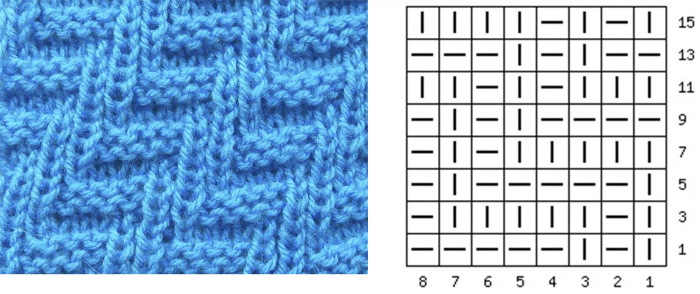
This pattern can be made in one color or in color. In both versions it will look original.
Openwork
There are more than 60 variations of double-sided openwork patterns. One of the popular ones is a pattern with squares (approximately 4x4 cm). This pattern is suitable for knitting stoles, summer snoods, sweaters and dresses from cotton or linen yarn.
Pattern rapport: 10 loops in width, 16 lines in height. To knit a sample, you need to cast on a number of loops that is a multiple of 10. Also add 3 additional and 2 edge loops.
How to knit:
- 1 chain starts with 2 loops knitted together with a left-leaning front loop, then make 1 yarn over. These actions need to be repeated 5 times. Then knit 2 more together with a left-leaning front loop, make a yarn over and knit 1 front loop.
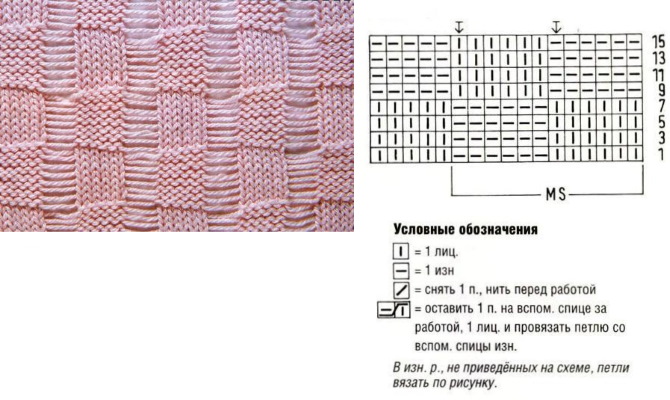
- In the 3rd row: 2 together knitwise with a tilt to the right. 1 throw over and 8 knitwise. Again 2 together knitwise with a tilt to the right. Again 1 throw over and 1 knitwise.
- 5 chain starts with 1 knit and yarn over. Next you need to knit 2 together knitwise with a left tilt. Make 7 knits, remove 1 loop, knit 1, make a yarn over. Knit 2 loops together knitwise with a left tilt.
- Lines 7 and 11 are knitted identically: 2 knits with a tilt to the right, yarn over, 2 knits. 2 together knits with a tilt to the right, 1 yarn over, 1 knit, 1 more yarn over, 2 together knits with a tilt to the left. 1 knit, 2 together knits with a tilt to the right. 1 yarn over and 1 knit.
- In the 9th line: 1 front, 1 throw over, 2 together front with a left tilt. 2 front, throw over, 3 together with front in the center, throw over, 2 front, 1 slip. 1 front, throw over, 2 front with a left tilt.
- 13th chain: 1 knit, yarn over, 2 knits with a left tilt, 7 knits, 1 slip, 1 knit, yarn over, 2 knits with a left tilt.
- In the 15th line: 2 together knitwise with a tilt to the right side, 1 throw over, 8 knitwise. 2 together knitwise with a tilt to the right side. 1 throw over and 1 knitwise.
Repeat points 1 through 7.
Arcade
Another openwork and beautiful pattern. It is suitable for knitting spring scarves, summer dresses and capes. In order to knit a sample, you need a number of loops that is a multiple of 12. You also need 3 additional loops and 2 edge loops. Each line begins and ends with an edge loop. All even rows are knitted with purl loops.
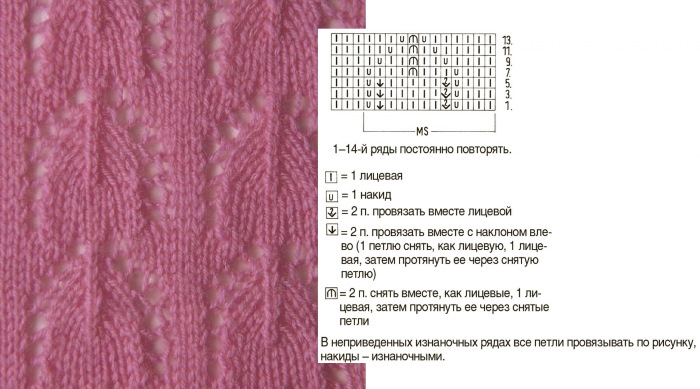
Step by step instructions:
- 1 line starts with 3 knits, 1 yarn over and 2 together knits. Then knit 5 knits, together with a tilt to the left, make 1 yarn over. Repeat these steps from the beginning, until the end of the line. 3 knits should close the chain.
- Chains 3 and 5 are knitted in the same way as 1.
- 7th line: 3 knits, 1 yarn over, 3 knits, knit 1 loop with a double tilt to the left. 3 knits, 1 yarn over, knit like this to the end of the line and finish it with 3 knits.
- In the 9th row, knit as follows: 4 front loops, 1 yarn over, 2 front loops, knit 1 st with a double tilt to the left, 2 front loops, 1 yarn over, 1 front loop, add 3 front loops at the end.
- Chain 11 starts with 5 knits, 1 yarn over, 1 knit. Then 1 loop needs to be knitted with a double tilt to the left. 1 knit, 1 yarn over, 2 knits. Finish the line with 3 knit loops.
- 13th row: 6 knits, 1 yarn over, 1 knit with a double tilt to the left. 1 yarn over, 3 knits, finish the chain with 3 knit stitches.
This pattern can be knitted not only with smooth but also with fluffy threads, for example, mohair.
Barrels
A versatile and easy pattern. The design looks like crossed cords. To knit the sample, you need a number of loops that is a multiple of 5, as well as 1 additional and 2 edge loops.
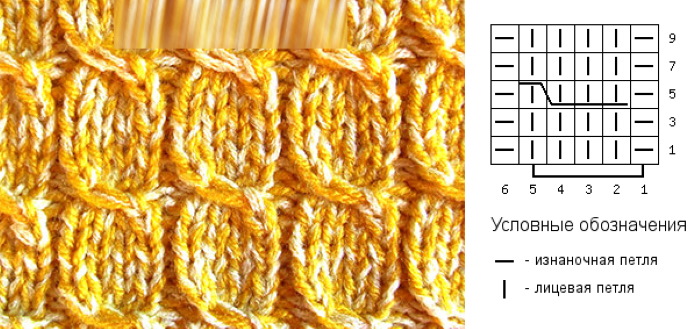
How to knit:
- 1, 3, 7 and 9 lines are knitted identically: 1 purl, 4 knit. Alternate until 1 loop remains. Knit it purlwise.
- The other 2 even chains are knitted in accordance with the resulting pattern.
- In the 5th line you need to knit: 1 purl, cross 4 loops to the left. At the end of the line knit 1 purl.
Then all actions start from point 1 again. It is not difficult to learn how to knit double-sided patterns with knitting needles. The main thing is to use the right threads and know how different loops are designated in the patterns. Following the step-by-step descriptions, you can independently repeat several popular patterns and knit a beautiful and original product.
Video about double-sided patterns
Double-sided knitting patterns:
